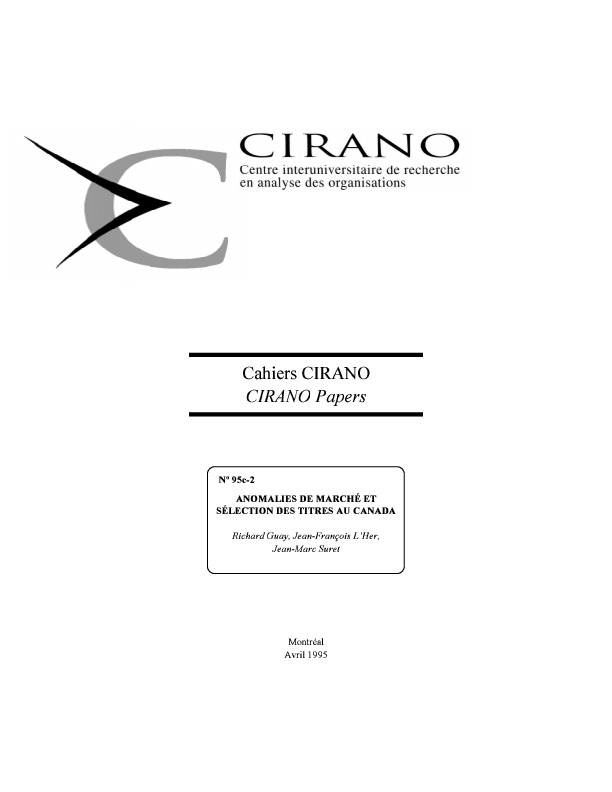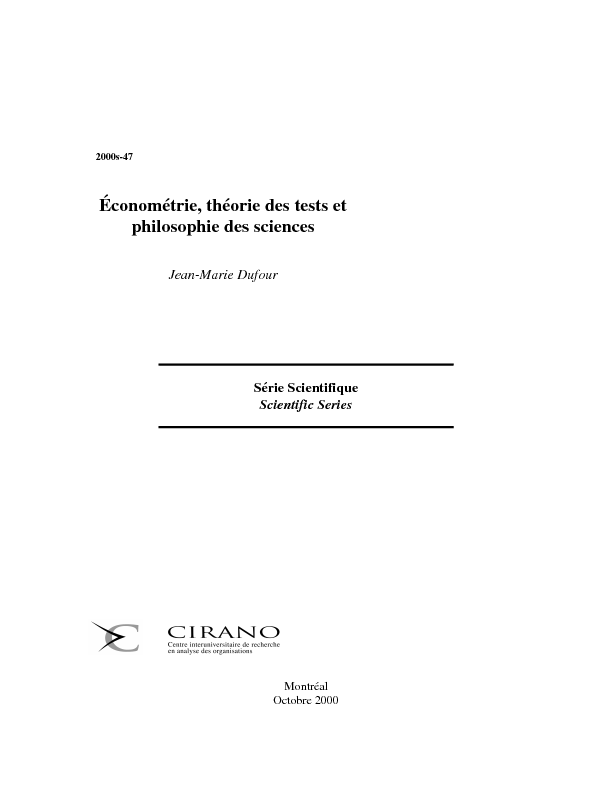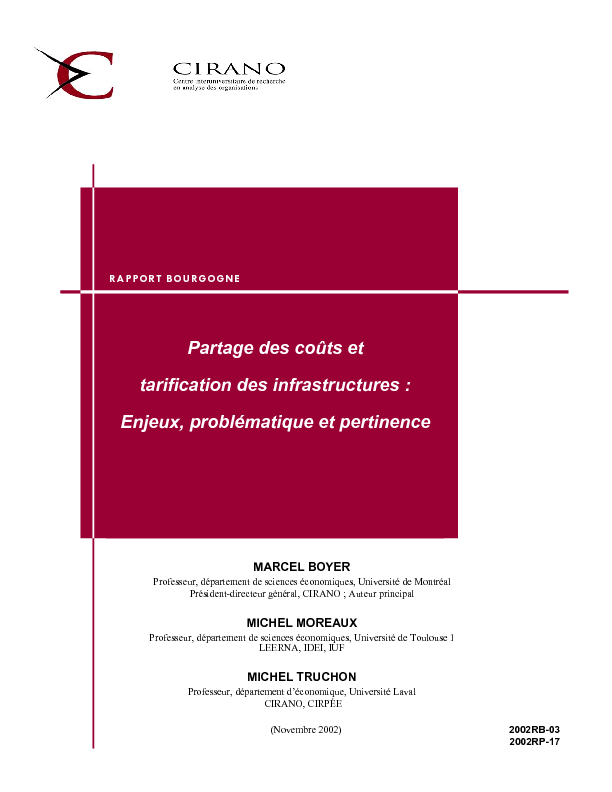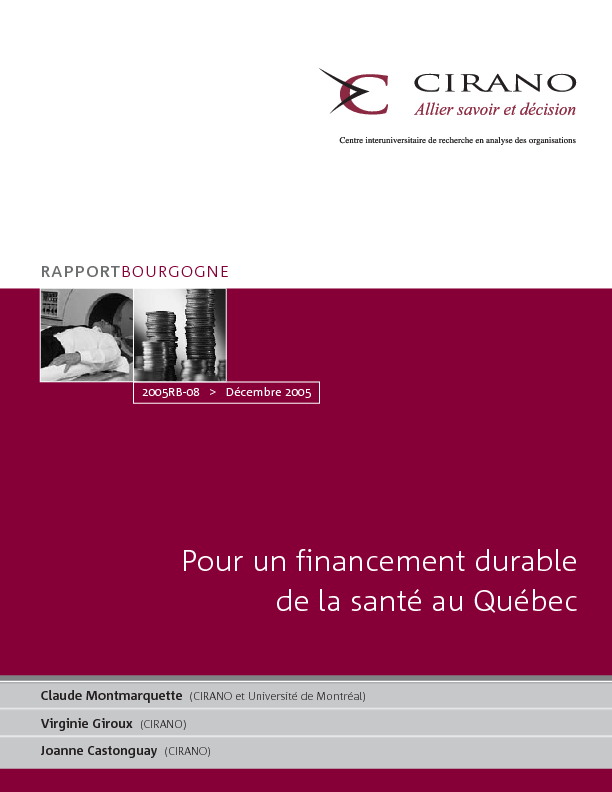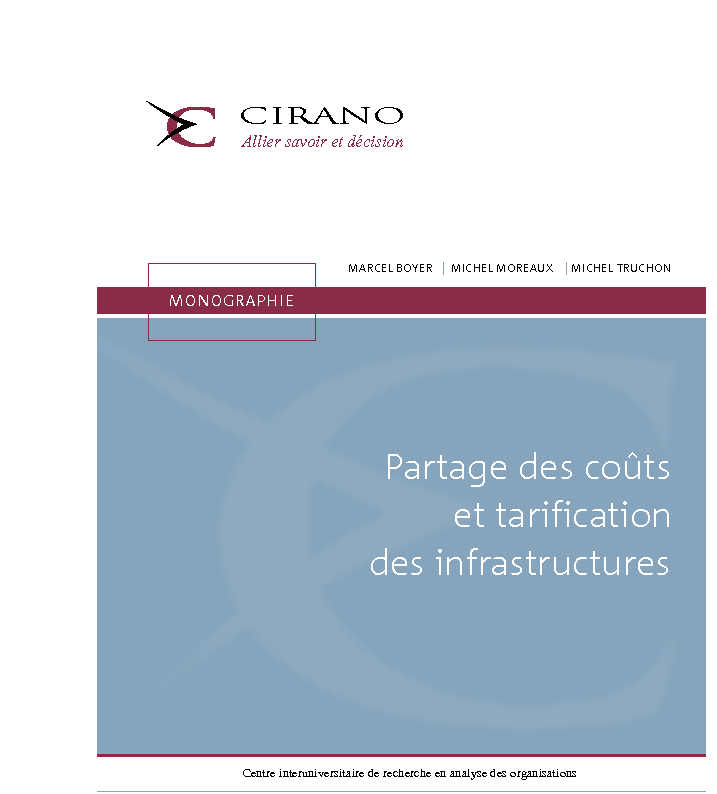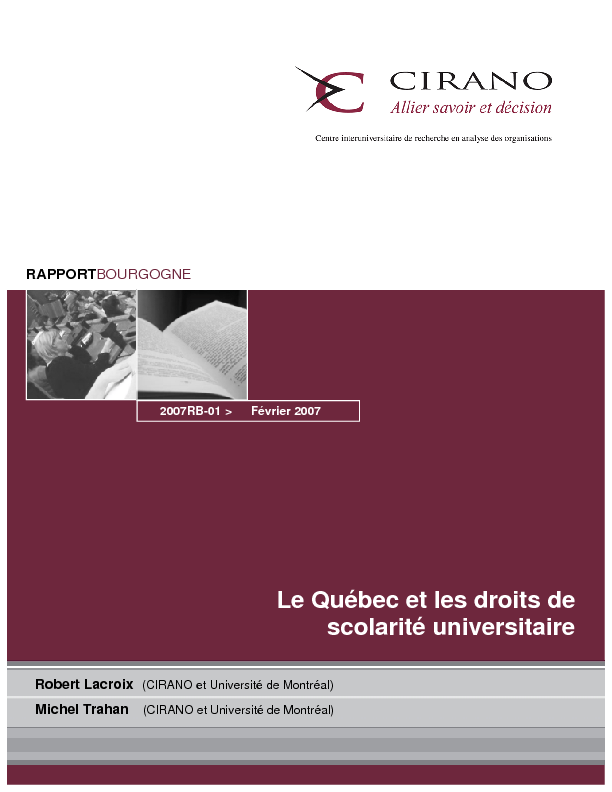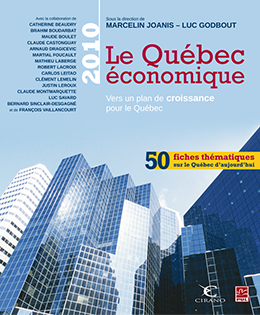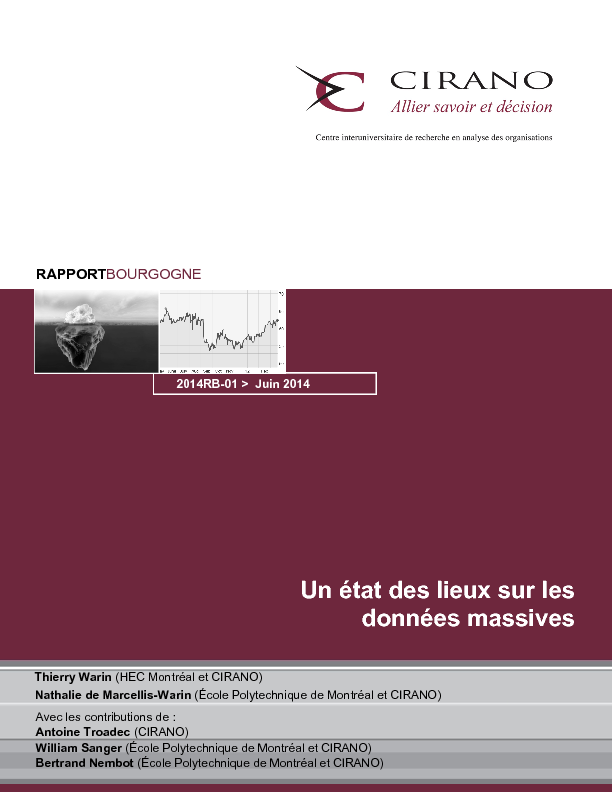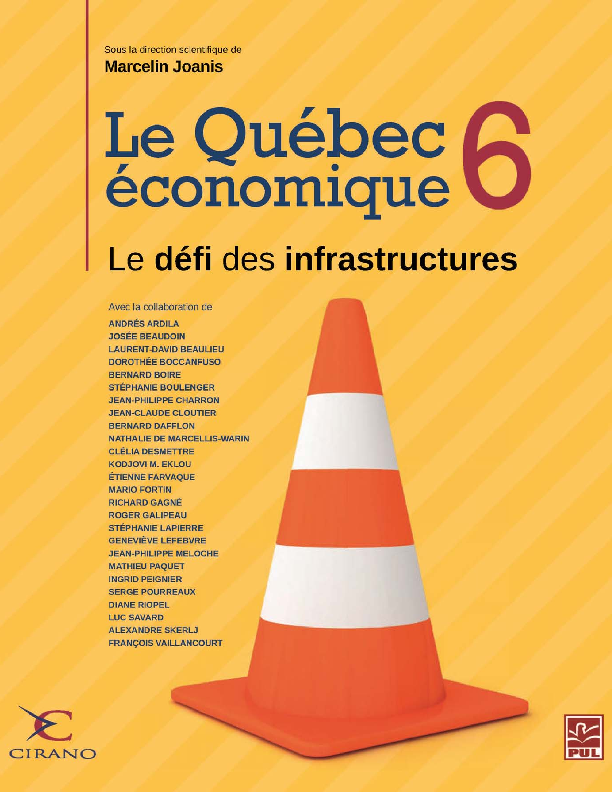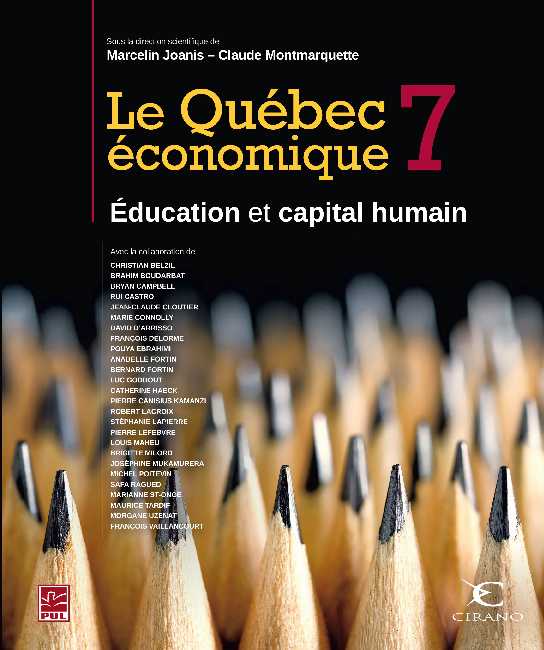Since its creation, CIRANO has had more than 1600 publications. On the occasion of CIRANO's 25th anniversary, we wanted to highlight the contributions of our speakers by means of a list of 25 of their texts published in French at CIRANO, one per year from 1994 to 2018. These 25 texts cover a wide range of themes related to the Quebec economy or public policies. After the conference, a revised version of this list will be used as a basis for the production of a book marking the 25th anniversary of CIRANO by publishing excerpts from these texts accompanied by a contemporary context by their original authors.
It goes without saying that many other publications could have been included in this list. It is not a compilation of the "best texts", or a compilation of the most cited texts. We invite you to delve into 25 years of contributions to Quebec policy research through a search in our publications database, where you will be able to access all CIRANO publications by a particular author.
Does a company have to do it itself or have it done: must it use its financial resources and organizational know-how to carry out a task or entrust its execution to another company (possibly specialized in this activity)? When it decides to have it done, how should it manage its relations with its suppliers, subcontractors, outsourcers, etc.? And when an organization decides to do so, how should it organize itself? These questions have received a lot of attention in recent years from management specialists and economists. In this brief, I propose an overview of the elements of response provided by the economy of organizations.
[ - ]This article jointly examines the effects of the size, earnings/price ratios and book value/market value of equities on Canadian equity returns. It presents an estimate of the risk premiums associated with each of these market anomalies. The results confirm the very volatile relationships between anomalies and returns of Canadian securities. Thus, even if the relationships exist _on average_, their use for stock selection purposes remains extremely risky.
[ - ]Who can afford to hire a construction worker to renovate their kitchen or repair their roof, pay them at the official rate and add GST and QST? Who has ever resisted the offer to pay a reasonable price for a service by paying "under the table"? Who has never participated in undeclared work, an important component of what specialists call the underground economy? How to define the latter? Does it cover smuggling and tax evasion activities? What are the methods commonly used to measure the underground economy? What is the extent of this in Quebec? What are the characteristics of individuals who carry out transactions as sellers or buyers? Which sectors are most affected? What is the share of legal activities not declared to the tax authorities? What about illegal activities? How does today's underground economy compare to that of the mid-1980s? What are the opinions and attitudes of Quebecers regarding this phenomenon? What are the main causes of undeclared work? Are the figures often reported in the media mythical or real? The general objective of this book is to present the descriptive results of a recent survey on the underground economy based on a sample of more than 5,000 individuals aged 18 and over living in Quebec. The conclusions are often surprising. It is up to the readers to judge. Five CIRANO researchers conducted this study: Bernard Fortin and Guy Lacroix, from the Department of Economics at Université Laval, Thomas Lemieux and Claude Montmarquette, from the Department of Economics at Université de Montréal, and Gaétan Garneau, research professional at CIRANO. This monograph is available from Universe Book Distribution 845 Marie-Victorin Street Saint-Nicholas, Que., G0S 3L0 Telephone: (418) 831-7474 or 1-800-859-7474 Fax: (418) 831-4021
[ - ]The GAMME project (Automated Generation of Multiple Electronic Markets) is a scientific and experimental research project aimed at developing the scientific and technical skills needed to set up market and exchange mechanisms and auction mechanisms on the information highway. The project is co-funded by Bell Canada and CIRANO. CIRANO (Centre Interuniversitaire de Recherche en Analyse des Organisations) is a research, liaison and transfer centre. It brings together university researchers and high-level research professionals whose mandate is to pursue cutting-edge university research and share the results with the rest of the Quebec community. It is within this framework that the project described in this document by CIRANO researchers was formed. The development of the information highway will have a major impact on the structure of our economy, on the organization of trade and relations between firms and on the acceleration of market globalization. The information highway has already begun to fundamentally change the value of trade, as evidenced by the adoption of EDI standards, the expansion of information highway networks and the creation of secure encryption and electronic payment methods: even governments are planning to convert to electronic commerce, particularly with respect to the purchase of goods and services. The objective of this project is to develop unique expertise in a niche that remains largely neglected in terms of e-commerce, namely the creation, design and implementation of markets and auction mechanisms on the information highway. We propose to leverage commercial and security intranets, "distributed object" computer systems technology and scientific market analysis to significantly reduce the costs associated with creating new markets and enable the development of electronic markets. Since online markets are the most advanced trading mechanism, it is to be expected that these types of institutions, with the help of technology, will gradually emerge. This project requires prior mastery of the advanced technology required for e-commerce, but also requires investment in scientific market analysis. In this regard, scientific expertise in the design of auction and exchange mechanisms has developed over the past decade. It has already been used (particularly in the case of telephone rights auctions, organized by the FCC) and will be used even more in the future for a wide range of applications. In addition, it is possible to imagine a host of commercial applications for the e-marketplace technology we wish to develop, and we believe that there is potentially considerable demand for the creation of such markets. In the meantime, we believe it is necessary to commit university resources to develop, on an experimental basis, the technical and scientific expertise necessary for the design and implementation of efficient markets adapted to economic conditions. In concrete terms, the project aims to create a software-prototype for exchange, set up an experimental economics laboratory and improve an analysis grid for the design of exchange mechanisms. In the medium term, CIRANO wishes to engage in pilot projects to develop practical expertise and create showcases for the concept of smart e-markets."
[ - ]The deterioration of the wage conditions of non-qualified workers has been the subject of considerable attention over the past few years. Unfortunately, it is not the sole preoccupation of public decision-makers. In this class of workers, the employment rate is particularly low, while unemployment tends to remain rather high. The first cause of non-qualification of young workers being their dropping out of school (the Canadian rate of dropouts from high school is 18%), any policy likely to reduce the dropout rates will be an effective means of improving the working situation of the youth. Our research identifies several determinants of dropping out and different policies which can be put into action by the governments in order to reduce dropout. We mention particularly the role played by the minimum wage in the dropout phenomenon: it is clear that a high minimum wage tends to increase dropout significantly
[ - ](Under the direction of Michel Poitevin) Outsourcing and subcontracting often appear to be synonyms: however, the two terms overlap distinct realities. Subcontracting refers to the modalities - economic or legal - of any form of delegation. Outsourcing refers to a business strategy and differs from outsourcing in that it has an essential managerial dimension: it involves not only the sale of a production activity as such, but also everything that motivates the decision to transfer responsibility for producing a good or providing a service to an external supplier. In other words, outsourcing includes a reflection on the desirability of outsourcing. Does a company have to divest itself of part of its production? How much business should it transfer to the subcontractor? How can it optimize the choice of its partners? What types of contracts should it sign? These questions delineate the specific domain of outsourcing because, depending on the answers provided, a manager will or will not outsource the product or service for which he or she is responsible. The texts presented in this book approach outsourcing from a dual management and economic perspective and shed new light on the phenomenon by presenting the theoretical arguments underlying outsourcing and illustrating these arguments with case studies. This monograph is available from Universe Book Distribution 845 Marie-Victorin Street Saint-Nicholas, Que., G0S 3L0 Telephone: (418) 831-7474 or 1-800-859-7474 Fax: (418) 831-4021
[ - ]In this text, we review some recent developments in econometrics that may be of interest to specialists in other areas than economics, and we discuss some relations of econometric methodology with general themes of scientific methodology and philosophy of science, such as the falsifiability criterion (Popper), the underdetermination of theories by data (Quine) and instrument-alism. In particular, we underscore the contrast between two styles of modelling the parsimonious approach and the statistico-descriptive approach and we analyze the links between statistical testing theory and philosophy of science.
[ - ]This volume was prepared by a select group of international experts in response to a need expressed by the Canadian government to identify and analyze some of the major challenges facing governments in conducting business in the knowledge-based economy. Special emphasis is placed on identifying the policy issues which governments will need to address in the upcoming years. This volume presents essays in three primary categories: Trends and Forces Shaping the New Reality Restructuring and Reorganizing in a Knowledge-Based Economy Key Governance Issues in the Knowledge-Based Economy Part one describes the salient features of the knowledge-based economy. What are its economic underpinnings? What are its technological characteristics? Whereas, in the past growth was determined primarily by the availability of land, natural resources, labor, and capital, at the end of the twentieth century knowledge has become the major factor of economic growth. Part two examines management issues and economic phenomena typical of a knowledge-based economy. What makes new technology adoption and implementation successful? What can government do to make it more successful? Part three is directly focused toward questions of political economy and economic policy considerations, including technical, economic, and societal solutions. The volume concludes with a summary of the new ways in which firms and governments should manage business in a knowledge-based economy. Doing Business in the Knowledge-Based Economy edited by Louis-A. Lefebvre, Élisabeth Lefebvre and Pierre Mohnen Boston: Kluwer Academic Publishers, 2001, 494 p.
[ - ]Most, if not all, organizations allocate common costs in one way or another among their various components or among their various partners. These common cost sharing problems are becoming increasingly acute as common cost sharing rules are important factors in competitiveness and performance. Although their explicit scientific analysis is already relatively advanced, their application within organizations (companies, alliances or business networks, governments) remains relatively embryonic and often dependent on an ad hoc historical approach, rather than rationally chosen to maximize organizational performance and value. We believe that organizations, broadly defined, would benefit from investing resources in learning common cost sharing methods that are more rigorous, efficient, equitable and incentive-based than those commonly used. We stress the importance of this investment in an economic context where the development of common infrastructures, both private and public, is omnipresent and conditions efficiency gains, which themselves have become the real cornerstone of competitiveness. We briefly present some cost sharing methods (Shapley-Shubik, nucleoli, sequential rule, ECPR, Ramsey-Boiteux, GPC). The study of these methods, which could better enhance the value of common infrastructures, is pursued in greater depth in the other documents in this series. Finally, we show how these methods have been or could be applied to nine problems that represent a much broader set of possible applications.
[ - ]"A clear success! Unprecedented participation levels! A fruitful partnership!" Such statements are a pleasure to hear, whatever the project in question or the context in which it took place. When these comments describe a project that allowed an organization to fundamentally transform its employees' and clientele's way of doing business by implementing state-of-the-art technology, and when this involved a joint effort of a government administration and a private firm, these testimonials are no longer simply delightful, they are (we must admit) astonishing. They are, however, remarks that were made following the establishment of the register of personal and movable real rights (RPMRR) at Québec's Ministère de la justice. This system, which consolidates information that was previously scattered throughout more than 200 different registers, has won several prizes, including one for Security awarded during the first Gala du commerce électronique, and the Treasury Board's Hommages 2000 prize to large organizations. Any attempt to identify a single explanation for this project's success would be futile. As the end result makes clear, it was the harmonious marshalling of assorted elements that allowed the delivery of a system to make its proponents proud: A clear vision of the role of information technology in public administration, the establishment of a completely original structure for the project team, professional and innovative project management, and eclectic personal and professional skills all played essential and complementary roles in the project's success. (This book is written in French)
[ - ]Under the direction of Benoit A. Aubert and Jean-Grégoire Bernard Organizations, whether private or public, local or global, diversified or not, operate in constantly changing environments, making the analysis and management of risk-performance relationships crucial. Risk management requires financial, technological and organizational measures to modify the relationship between environmental turbulence and variability in outcomes. Hence the importance of an integrated vision of organizational risks. The challenge of integration is to expand the areas of use of existing techniques, identify gaps and develop new measurement tools. This book is part of this trend, which first presents the measures used in various fields before dealing successively with financial risks, project management risks, contractual risks, major industrial risks, human health risks and environmental risks. After presenting the different modes of integration, the authors describe and analyze the case of a company that must evaluate an expansion project, taking into account this concept and practice of integrated risk measurement. Published by Les Presses de l'Université de Montréal, ISBN 2-7606-1966-4; 524 pages; price: $69.95 To order the book: https://www.pum.umontreal.ca/catalogue/mesure-integree-du-risque-dans-les-organisations
[ - ]The Quebec health system is in a delicate situation. On the one hand, the annual growth rate of health expenditure over the past twenty years has been systematically higher than the GDP growth rate (by 1% on average). On the other hand, the government is finding it increasingly difficult to meet the demand for funding for health services. However, the demand for services continues to increase, with three factors exerting significant pressures on the demand for care: enrichment, an aging population and technological developments. As a result, health expenditures are taking up an increasing share of government budgets at the expense of their other jurisdictions. For several years, the long-term sustainability of the health system has been at the heart of the concerns of Canadian, federal and provincial governments. In this context, several public commissions have recently been set up to study the issue in depth. When we look at their recommendations, we see that the majority of these commissions agree that our health system is not sustainable without profound changes in the means of financing it. This report assesses the many recommendations made by Canadian public commissions regarding their potential contribution to the financing of the health system, and more specifically their impact on the supply and demand for health services. The impact of structural reforms In the case of a private good or service, the price and quantity consumed are determined by the balance between supply and demand. In the case of a publicly funded service, it is the government's budget that determines the quantity of services offered; the offer is therefore fixed. In addition, the price charged is nil, so there is almost unlimited demand. This set of factors leads to significant rationing which, in terms of health, translates into waiting times for the population. In Quebec, these are long; many believe they are too long. The structural reforms proposed by the various public commissions can be classified, according to their objectives, into three categories, namely those aimed at - improving productivity - control of the service offer - demand reduction The first two categories (which incidentally represent the vast majority of structural reform proposals) concern improving the supply of services. Interestingly, they are unanimously supported by the various Canadian public commissions1. However, their impact on the financing issue is limited since they are interested in the supply of services and the problem is one of growing excess demand. Any improvement in productivity and service quality will have an impact similar to an increase in the health budget. However, as demand is very much in excess, the effect of these reforms will be barely noticeable to the public. The third category of proposed reforms includes only one proposal, to increase disease prevention initiatives. This proposal would have the effect of reducing the demand for services, which is excellent news in itself, since this effect would be the opposite of the effects of population aging and enrichment. However, this proposal is insufficient since its effect will only be felt in the long term. Moreover, since it has no effect on the price, which is nil, demand will remain significantly in excess. In conclusion, if no measures are adopted to reduce demand in the short term, the system will remain in a state of crisis. The impact of the financing reforms Funding for the health system comes from two potential sources: the public and private sectors. The impact of increased public funding. The sources of increased provincial public funding are fourfold: - taxes - federal transfers - increased wealth - improved public financial management Any policy that increases the tax burden on taxpayers is unlikely, as Quebecers already bear one of the highest tax burdens in the world. Moreover, since federal taxes are paid by the same taxpayers, an increase in federal transfers is not a solution. As for increasing collective wealth, it is extremely difficult to achieve, given the limited resources available to Quebec. In fact, the best option would be to adopt measures of fiscal prudence, starting with the repayment of the public debt. This would increase the government's flexibility. M
[ - ]A real valuation of common infrastructures must be based on a rigorous approach to sharing their implicit if not explicit costs and pricing. Hence the interest and relevance of this book, which is intended to be both a one-stop shop and an update of the work we have done on this subject in recent years within the Centre interuniversitaire de recherche en analyse des organisations (CIRANO). Most, if not all, organizations allocate common costs in one way or another among their various components or among their various partners. These common cost sharing problems are becoming increasingly acute as sharing rules or formulas are important factors in competitiveness and performance. Although their explicit scientific analysis is already relatively advanced, their application within organizations (companies, alliances or business networks, governments) remains relatively embryonic and often dependent on an ad hoc historical approach, rather than rationally chosen to maximize the organization's performance and value. We believe that organizations, broadly defined, would benefit from investing resources in learning common cost sharing methods that are more rigorous, efficient, equitable and incentive-based than those commonly used. We stress the importance of this investment in an economic context where common infrastructures, both private and public, are omnipresent and determine efficiency gains, which themselves have become the real cornerstone of competitiveness. In this book, we systematically present the sharing methods found in the economic literature. We group them into three categories: proportionality rules, rules based on cooperative game theory and serial cost sharing rules. Each of the methods presented is illustrated with an example, that of a gas pipeline that would connect Saguenay-Lac-Saint-Jean and Beauce to Montreal, via Quebec City, capable of serving these three regions. It is important to choose a cost-sharing method based on its properties, even before knowing the results it can produce. One objective of this book is to distinguish cost allocation methods on the basis of general properties that they may or may not satisfy. We set out a number of properties related to equity and consistency that are desirable in general or in certain circumstances. We present various results indicating which properties are satisfied by which methods in which contexts. We then present the notion of cost play. A cost set is defined as a cooperative set in which the gain from cooperation is the reduction in expenses made possible by the coordinated implementation of the projects of a set of agents. The problem is then to know how these agents will distribute this gain, i.e. this cost reduction, or in an equivalent way how they will contribute to the financing of the expense thus incurred. We identify the main types of cost sets and introduce the concepts of pre-solution and solution as well as the properties usually required of a solution. We then present the main solution concepts proposed for cooperative games, several of which have been used to solve cost sets. We devote a privileged place to the study of the concept of the heart. We also study the concepts of semi-heart, stable von Neumann and Morgenstern ensemble, nucleolus and Shapley value. As a typical application, we present the case of cost sharing for some municipal infrastructure. In municipalities of a certain size, water, wastewater, natural gas distribution, electrical distribution, telecommunications, etc., all pass through pipelines that are grouped underground. The construction of these structures involves very high fixed costs, which must be shared between the various users. The problem of allocating the costs of a network of underground pipes has particular characteristics. We illustrate them with an example and, after reviewing the proportional allocation methods, including the method of allocating costs in proportion to the length of the conduits allocated to users, we present two methods that seem most interesting in this context, the Shapley-Shubik rule and the sequential allocation method.
[ - ]In this Burgundy report, the authors first have the argument that the government does not have the means to freeze school fees. Justifying the thawing of tuition fees with such an argument distorts the debate and obscures the real problems arising from low and uniform tuition fees. Then, the authors show to what extent the private positive return on the individual's investment in university education is not only widespread, but frequently very high. They also contradict the assertion that higher taxes more than offset the costs of education borne by the state and legitimize free education at university. They then discuss the important issue of accessibility to university studies. They then show that accessibility is largely determined before university entrance and that there are perverse effects resulting from tuition fees that are not only low but uniform in all fields of study. The authors then present a new funding formula for universities that would increase accessibility despite the thaw in tuition fees; that would promote informed and optimal student choices; and that would encourage universities to achieve excellence and relevance in their training mission. The authors conclude by saying that the tuition freeze has already had a significant impact on the accessibility of those who are truly in need and on the quality of university teaching and research in Quebec. There is an urgent need for university tuition fees to be thawed, gradually brought up to the Canadian average and deregulated to better reflect training costs by discipline sector. To the extent that a significant portion of the additional resources generated by this thaw will be devoted to programs focused on reducing the accessibility gap between youth from affluent socio-economic backgrounds and others, overall accessibility to university will increase and the redistribution of income from the less affluent to the rich, as promoted by the current situation, will decrease.
[ - ]The Québec economy is subject to economic, social and environmental risks. It is constantly mentioned that our companies now operate in a globalized environment, more competitive than ever. This document analyses the overall risks facing Quebec. Subsequently, a detailed analysis shows that the reading of the Chinese economy is more complex than current data suggest. Second, analysis of service offshoring in low-cost countries such as India shows that this response to increased competition is not without risk. Finally, innovation remains a key tool to support the competitiveness of Quebec firms. The analysis provides a better understanding of how to support this innovation and transform it into a tool for social, environmental and economic growth.
[ - ]By choosing Le Québec économique 2009 as the title, we were voluntarily paving the way for a two-stage analysis. On the one hand, we wanted to assess the Quebec economy by measuring the progress it has made over the past few decades to date. On the other hand, we wanted to pay due attention to a year that, let us say, is clearly out of the ordinary. A thematic look at 2009 highlights that it was the year of all the dangers for the global economy. Starting from a financial crisis that peaked at the end of 2008, as Pierre Fortin noted, it quickly spread to the real economy, dragging the world economy into its first technical recession since global production data were compiled. As expected, the global recession soon hit Quebec, which entered recession in the fourth quarter of 2008. While the recession in Quebec was initially difficult to assess, the first quarter of 2009 was marked by the announcement of historical losses by the Caisse de dépôt et placement du Québec. These losses made Quebecers realize that the global financial crisis would have profound consequences that would affect them. As Mathieu Laberge, Marcelin Joanis and François Vaillancourt suggest, the important thing is to ensure that the Caisse has the capacity to bounce back and take advantage of the recovery to ensure the sustainability of the pension plans for which it is responsible. As 2009 progressed, as Jean-Pierre Aubry's comments testify, the financial impacts of the crisis were replaced by the labour market impacts of this first recession in Quebec and Canada for more than 15 years. Job losses and falling corporate profits, combined with the other impacts of the financial crisis and recession, have had a devastating effect on Quebec's public finances. As a result, the government announced a series of deficit budgets in the spring of 2009 and temporarily suspended the Balanced Budget Act, making the targets set out in the Debt Reduction Act seem very distant today. However, as Youri Chassin and Marcelin Joanis point out, we cannot overemphasize the importance of quickly returning to structural balance and staying the course, in the medium and long term, on debt reduction in Quebec. In this regard, as Luc Godbout and Suzie St-Cerny illustrate, returning to balanced budgets will be a difficult task that will require us to make difficult societal choices now. To achieve this, as Mathieu Laberge and Claude Montmarquette argue, budgeting practices must be established to improve budget planning over a long period of time. Because it is obviously in the long term that we must consider the challenges facing the Quebec economy and public finances. And there are many challenges. In each of the chapters of Part I, based on interprovincial and international comparisons, a series of structural challenges were highlighted: Delays in productivity and economic growth; A less dynamic labour market and a lagging labour force education rate; Individual and family incomes significantly lower than the rest of Canada; An aging population and a persistent interprovincial migration deficit; Increasing gaps in population growth and economic dynamism between metropolitan and peripheral regions; A high tax burden by international standards; Higher public spending than the rest of Canada and upward pressure; and High public debt by international standards. Book written under the direction of Marcelin Joanis and Luc Godbout. To order the monograph, "click here"
[ - ]Edited by Marcelin Joanis and Luc Godbout While Quebec was hit less severely than elsewhere by the last recession, it still faces significant economic challenges before the recession: the impending contraction of the pool of potential workers, collective wealth lower than that of its neighbours, too modest productivity growth, too high a dropout rate, etc. To meet the many challenges of economic growth, Quebec must be bold and innovative while building on its recent successes. This book examines the various economic challenges facing Quebec today. In the first part, renowned university researchers and Quebec personalities present their point of view in an accessible way and contribute their thoughts on the factors that foster economic growth, from human capital to savings, innovation and the role of government. With the help of some fifty thematic sheets containing the most relevant indicators, the second part provides readers with key figures to decipher the major trends in the Québec economy. To order the monograph, click "here "
[ - ]With the fog hanging over global economic growth, Quebec's economic environment remains uncertain. For this third edition, Le Québec économique addresses the main issues facing the health system. This key sector of the Québec economy is a major factor in economic growth. The importance of its public financing makes it a central element in maintaining sound public finances. In this book, authors from various backgrounds present in an accessible way their thoughts on various aspects of Quebec's health system and economy. In addition to providing an economic analysis of health services and their public funding, they address a range of themes, from business models to physician compensation, access to family physicians, medical liability, personalization of care, prevention and the importance of health in worker productivity. Using 50 thematic sheets containing the most relevant indicators, the book provides readers with data that help them understand the major trends in the Québec economy. To order the monograph, click here
[ - ]Certain public decisions, major projects or social issues in Quebec may give rise to concerns or fears. Whether we are talking about undertaking the refurbishment of the Gentilly-2 nuclear power plant, developing the shale gas industry, building a new bridge, retirement income, obesity, access to health services, some of these projects or issues are of concern to the people of Quebec. This book presents the results of an unpublished survey of a representative sample of the Quebec population. The CIRANO 2012 Barometer provides answers to the questions asked by all major project managers: - What is on the minds of Quebeckers today? - What are the projects and issues perceived as the most risky? - What is the level of trust placed by the population in the government for its management of 30 specific projects and issues? - What are the sources of information most used by the population? - How would the population react to the announcement, for example, of the construction of a new nuclear power plant? This book is particularly aimed at managers of major projects, political decision-makers and all citizens. Nathalie de Marcellis-Warin: Holder of a doctorate in management science, Nathalie de Marcellis-Warin is an associate professor in the department of mathematics and industrial engineering at École Polytechnique de Montréal. She is Vice-President of the Risk and Sustainable Development Groups at the Centre interuniversitaire de recherche en analyse des organisations (CIRANO). It is also an associate member of CIRRELT (Centre interuniversitaire de recherche sur les réseaux d'entreprises, la logistique et le transport) and CIRST (Centre interuniversitaire de recherche sur la science et la technologie). She is also president of the RISQ+H network, a network for raising awareness and sharing experiences on risk management, safety and quality of care in hospitals. Ingrid Peignier: Engineer and holder of a Master's degree (M.Sc.A.) in industrial engineering, Ingrid Peignier is a project manager in the Risk Group at the Centre interuniversitaire de recherche en analyse des organisations (CIRANO). It specializes in the identification, assessment, management and communication of major industrial risks. To buy the book, click "here"
[ - ]ARGUMENTARY Companies' logistics strategies include supply and distribution choices and material storage policy choices, made in an often complex regulatory context, with multiple levels of government and, most of the time, a large number of stakeholders. To improve their profitability, companies are constantly seeking to maximize the efficiency of their supply chains. Those working with hazardous materials have an additional challenge: they must take into account the potential risks of these substances to workers, the public and the environment at each link in their chain. They must therefore integrate risk management into their logistics and operational decision-making processes. As the Lac-Mégantic tragedy in Quebec, which occurred on July 6, 2013, painfully reminds us in terms of risk management related to hazardous materials, even the most improbable catastrophic scenarios can occur. TARGET The purpose of this book is to provide stakeholders in the field (transporters, producers, planners, legislators) as well as individuals who wish to learn more about hazardous materials issues with a set of essential information. The various chapters include, on the one hand, first-hand data and, on the other hand, a reflection on the various aspects of logistics strategies and the risks associated with the storage, handling and transport of hazardous materials. To buy the book, click "here"
[ - ]Massive data is everywhere. They are increasingly identified and collected for strategic purposes for companies or to measure risks for governments. The exploitation of massive data is bringing about significant changes in our societies. We are now at the beginning of a real industrial revolution. With new opportunities, new challenges and risks also emerge. Massive data have legal, political, moral and economic citizenship. This report highlights that the territoriality of data is an important issue at the beginning of the 21st century. This report is an inventory of the situation at the beginning of 2014. It is not intended to be exhaustive and cannot be. Technological advances are moving so fast that we will have to continue to contemplate the ongoing revolution. The bibliographical references selected are those that could be grouped under the themes chosen in this report. This is a brand new literature that is still in its infancy and the future is undoubtedly promising. Massive data is a radical process innovation.
[ - ]Even if Quebec seems to be a small player on the world economic scene, this does not mean that its role is minor. Rich in natural resources, technology and human capital, Québec has undeniable assets. Its comparative advantages are numerous and can enable it to play the role of an important partner in global value chains. However, Quebec must consider the major changes that are emerging at the beginning of the 21st century to strengthen its international competitiveness and face many challenges. Will Quebec find its way in an increasingly complex world? In this book, renowned authors present an in-depth analysis of Quebec from the perspective of globalization. After having made a diagnosis of the major trends of the early 21st century and how these major changes are affecting countries and economic regions, an assessment of Quebec's position in this new international context is proposed. Based on rigorous analyses and results, the authors illustrate how Quebec is working (or not) to mobilize its assets in order to turn them into real comparative advantages at the global level. To order the book: http://www.presses-polytechnique.ca/fr/economie-du-quebec-2015-l-contexte-et-enjeux-internationaux
[ - ]The ageing of the population and the acceleration of economic growth in emerging countries, particularly China, have led many economists to say that the time has now come to see economic growth in developed countries slow down. Some even talk about a new standard, indicating that this slower growth will be a permanent phenomenon and that it is better to get used to it. Where is Quebec in all this? What decisions must be made by our leaders to maximize, in this context, the province's economic potential in the short, medium and long term? In an attempt to answer these major questions, this book calls on 13 economists, who have given themselves the mandate to write a practical guide. The recommendations are clear and the analysis made is accessible to all readers who want to know more about Quebec's economic future. From the "Point de mire sur le Québec économique" series, edited by Mario Lefebvre with Marcelin Joanis and Luc Godbout and published by Presses de l'Université Laval (PUL), the book is available electronically via the PUL website or in bookstores.
[ - ]International organizations are formal: all countries must invest more in infrastructure. The objective is to develop and maintain a network of advanced infrastructure to support economic growth. For developed countries, it is mainly a question of compensating for the ageing of infrastructures, sometimes more than a hundred years old. In Quebec, this challenge is particularly acute because of the simultaneous rehabilitation of many infrastructures built in the 1960s and 1970s. This sixth volume of the series Le Québec économique deals in depth with the various facets of the infrastructure challenge in the context of a slow-growing Quebec economy. After having established an inventory of the Quebec economy and infrastructure park, the book discusses the economic effects and financing of infrastructure, maintenance and prevention, public construction contracts, as well as technological infrastructures. This book was written under the direction of Marcelin Joanis, Vice-President of Economic Development at CIRANO. Published by Presses de l'Université Laval (PUL), the book is available in bookstores or electronically. For more information, click here.
[ - ]Nearly a quarter of the Government of Quebec's expenditures are allocated to the education sector. For a society, education acts both as an engine of economic growth and as a powerful tool in the fight against poverty. Investment in education allows the accumulation of human capital, a key factor in individual development. This seventh edition of Québec économique takes stock of contemporary issues in the Québec education system. To position the analysis correctly, portraits of the primary and secondary network and then of higher education are first presented. A series of economic issues are then studied in detail. In particular, the following topics are addressed by researchers recognized in their field: the financing of higher education, the performance of the education network as well as the private and social returns to education. More information
[ - ]
